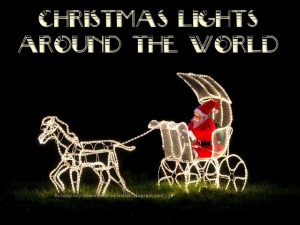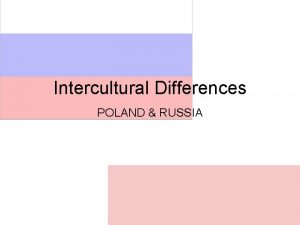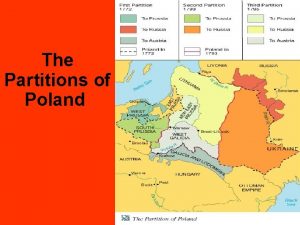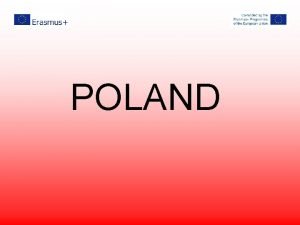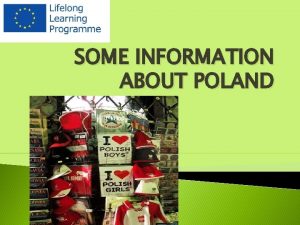Poland General information Poland is the largest of









- Slides: 9

Poland

General information � Poland is the largest of the East European countries which joined the EU in May 2004. Poland is comparable in size to Italy or Germany (in USA larger than New Mexico) and with a population of approximately 39 million (e. g. more than California) it ranks among the most influential and remarkable countries in central and Eastern Europe. Poland is a stable democracy with a truly fascinating history, great cultural heritage and several areas of outstanding natural beauty.

Famous astronomers � Nicolaus Copernicus, Polish Mikołaj Kopernik (born February 19, 1473, Toruń, Poland—died May 24, 1543, Frauenburg, East Prussia [now Frombork, Poland]), Polish astronomer who proposed that the planets have the Sun as the fixed point to which their motions are to be referred; that Earth is a planet which, besides orbiting the Sun annually, also turns once daily on its own axis; and that very slow, long-term changes in the direction of this axis account for the precession of the equinoxes. This representation of the heavens is usually called the heliocentric, or “Sun-centred, ” system—derived from the Greekhelios, meaning “Sun. ” Copernicus’s theory had important consequences for later thinkers of the scientific revolution, including such major figures as. Galileo, Kepler, Descartes, and Newton. Copernicus probably hit upon his main idea sometime between 1508 and 1514, and during those years he wrote a manuscript usually called the Commentariolus (“Little Commentary”). However, the book that contains the final version of his theory, De revolutionibus orbium coelestium libri vi (“Six Books Concerning the Revolutions of the Heavenly Orbs”), did not appear in print until 1543, the year of his death.

Maria Cunitz(1718 -1799) � Maria Cunitz or Maria Cunitia (other versions of surname include: Cunicia, Cunitzin, Kunic, Cunitiae, Kunicia, Kunicka) (Wołów, Silesia, 1610 – Byczyna, Silesia, August 22, 1664) was an accomplished German astronomer, and one of the most notable female astronomers of the modern era. She authored a book Urania propitia, in which she provided new tables, new ephemera, and a more elegant solution to Kepler's problem. The Cunitz crater on Venus is named after her. The minor planet 12624 Mariacunitia is named in her honor.

Thomas Zebrowski studied philosophy and theology at Vilnius University. He briefly taught at Jesuit schools in Kražiai, Ilūkste, and Babruysk and prepared construction projects for churches in these towns. They displayed features of Baroque churches in Vilnius. He also designed the Jesuit school in Zhodishki (Жодишки in Belarus), houses for nobles, and other buildings. Though documentary evidence is lacking, it is suspected that Zebrowski was also involved in construction of churches in Minsk and Płock, Oginski residence in Ručyca (Hanuta) village. � After studying at Charles University in Prague under Joseph Stepling in 1750– 52, Zebrowski returned to Vilnius, becoming a popular lecturer of physics and astronomy at Vilnius University. He was also interested in geodesy, horology, mineralogy, geography. However, his major passion was astronomy and he pursued funding for an observatory. The construction was funded by Elżbieta Ogińska-Puzynina, while Mikolaj Radziwill and bishop Józef Sapieha donated 13. 5 -centimetre (5. 3 in) and 10 -centimetre (3. 9 in) diameter reflector telescopes manufactured in Germany. Zebrowski designed the observatory; its construction began in 1753. �

Polish Cuisine � � With the end of communism in Poland in 1989, an avalanche of new restaurants started to open and the basic foodstuffs were once again easily obtainable. This led to a gradual return of rich traditional Polish cuisine, both in home cooking and in restaurants. At the same time, restaurants and supermarkets promoted the use of ingredients typical of other cuisines of the world. Among the most notable foods that started to become common in Poland were cucurbits, zucchini and all kinds of fish. During communist times, these were available fresh mostly in the seaside regions. Recent years have seen the advent of a slow food movement, and a number of TV programs devoted to other cuisine and as well as traditional Polish cuisine have gained popularity. In 2011 a nostalgic cookbook (written in English) combining a child's memories growing up in the Gierek era with traditional Polish recipes was published in London. American food in Poland, most commonly Mc. Donald's, KFC and Pizza Hut, are declining in popularity as Polish people prefer their own cuisine. Meanwhile, Doner kebabs are starting to gain popularity. Nonetheless, in most of Poland one can still get traditional and very popular Polish fast-food such as zapiekanka (baguette with cheese, mushrooms, onion or peppers, sometimes meat and ketchup), kebab, hamburgers, hot dogs and sausage. There also many small-scale, quick-service restaurants which usually serve items such as zapiekanka.

Holiday meals � � � Christmas dishes in Poland Polish Christmas breakfast Traditional Christmas Eve supper called Wigilia is meatless, usually consists of barszcz (borscht) with uszka (small dumplings) – a classic Polish Christmas Eve starter, followed by fried carp, carp fillet or cod with apple & leeks fresh salad, carp in aspic etc. traditionally carp (fried or Jewish style) provides a main component of the Christmas Eve meal across Poland. Other popular dishes, for the next day, include pickled matjas herring, rollmops, pierogi with sauerkraut and forest mushrooms, fish soup, kiełbasa, hams and bigos (savory stew of cabbage and meat) and vegetable salads. Among popular desserts are gingerbread, cheesecake, various fruits like oranges among others, poppy seed cake makowiec (makówki in Silesia), fruit kompot, kluski with poppyseed, kutia sweet grain pudding in the eastern regions, like (Białystok) and ginger bread. Regional dishes include żurek, siemieniotka (in Silesia), and kołduny - mushrooms or meat stuffed dumplings in the eastern regions

Easter breakfast � A typical Easter breakfast often consists of cold-cuts served with horseradish sauce and beet salads, breads, bigos, żurek, kiełbasa, smoked salmon or herring, marinated vegetable salads, Easter salad (chopped boiled eggs, green peas, cwikła, carrot, apple, potato, parsley and mayonnaise) coffee, tea and cakes, i. e. chocolate cake, makowiec, mazurek, sernik, etc .

The End � Source : Wikipedia You can find polish words in the mini-dictionary I did.










